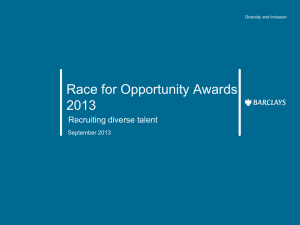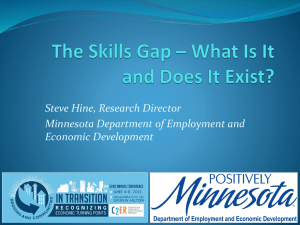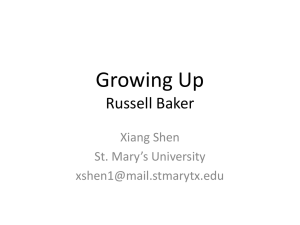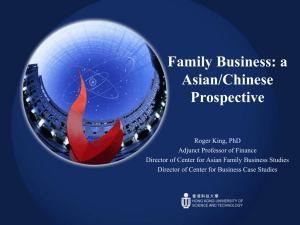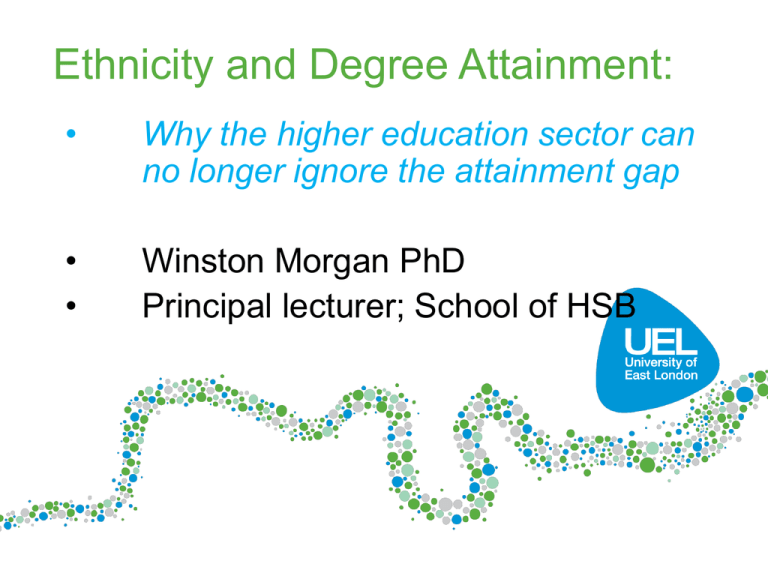
Ethnicity and Degree Attainment:
•
Why the higher education sector can
no longer ignore the attainment gap
•
•
Winston Morgan PhD
Principal lecturer; School of HSB
The presentation will cover:
• An overview of the attainment gap
• The relevance of the gap
• BAME attainment nationally and at mission
groups with large BAME student populations
(Million+ and Russell group)
• Provide some explanations for the attainment
gap
• Offer some strategies to narrow the gap
Sources of information (1999-2013)
• Equality Challenge Unit (www.ecu.ac.uk/ )
• HESA (www.hesa.ac.uk/ )
•
HEIDI (www.heidi.ac.uk)
• UCAS (www.ucas.com)
• UEL (MIS)
• Publications by HEA, Hefce
• Conferences
• Interviews with BAME students at UEL
Warning!!!
• This presentation contains a lot data and
statements on attainment that some may
find uncomfortable.
Context of the presentation
• Many in academia are familiar with the
general causes of the attainment gap.
• Qualifications, age, socio-economic ,
• Few have a deeper understanding of why
these factor impact on attainment and
what to do. So the attainment gap
remains.
• Fewer in academia have an understanding
of other more difficult to understand
factors which also determine attainment.
• Practices and policies.
• The interaction between Identity, a student
perception of self and the messages sent
by the institution.
• The prospectus says” come to our shiny
university have a great experience and
leave with a degree that will set you up for
life”
• It does not say in the small print that it will
only occur if you fit a certain profile
What is the attainment gap?
• For some time in the HE sector there has
been significant differences in attainment
(good degrees) between BAME students
and their white counterparts.
• the “attainment gap”
• Good degree: 2:1(upper second) or first
• BAME: Black, Asian and Minority Ethnic
Relevance?
• Over 20% of students in HE are BAME (some
institutions >50%)
• A high proportion of international students are
BAME (growth areas)
• Interaction with our stakeholders
• League tables
Half the criteria for University League Tables are directly
impacted on by BAME student attainment.
University league tables categories
Student satisfaction
Research quality
Entry standards
Student-staff ratio
Services & facilities spend
Completion
Good honours
Graduate prospects
• Fees
• Legal obligation ?
The attainment gap in practice
• A black student with “AAA” at A level
studying at Russell group university has
less chance of gaining a good degree than
a white student with “CCD” studying at a
post-92 university.
• For post-92 and Russell group institutions with a
large or majority BAME student population,
narrowing the attainment gap should be a
priority.
• The “success” of such institution is directly
dependent on the performance of BAME
students.
• Worryingly the gap has not significantly changed
since 2003.
• Clear evidence of an attainment gap.
• Two initial questions
•
Is the gap unique to UEL?
•
What determines the attainment gap?
• A more detailed examination of BAME
attainment:
•
Nationally
•
At mission groups with large BAME
student populations (Million+ and
Russell group)
The picture nationally
• Nationally BAME students make up 1722% of the HE population, mainly
concentrated in post-92 institutions and
inner city Russell group universities.
• BAME make up about 9% (12-14%) of the
population (pre 2011 census)
Breakdown of
graduating
UK students White Bl Carib Bl Afr
As Ind As Pak As Bang Chin
Mix
BAME
% HE Pop
80
1.4
3.7
3.5
2.2
0.9
0.9
3.9 20
% Pop Eng
86
1.1
1.8
2.5
2.0
0.8
0.7
1.7 10.6
HE pop/Gen
Pop
-7
27
105
40
9
13
29
% Million+
15
33
34
18
25
30
8
19
20
% Russell
24
7
9
24
13
14
33
24
16
130 89
Attainment
UK
2011/12
White Bl Carib Bl Afr
As Ind As Pak As Bang Chin
Mix
BAME
% Ist
19
5
6
13
9
9
15
14
11
GD
71
45
42
60
50
51
64
64
54
26
29
11
22
20
8
8
17
Gap
Attainment
Russell
Group
White Bl Carib Bl Afr
As Ind As Pak
As Bang Chin
Mix
BAME
1st
23
4
9
18
13
12
20
20
17
GD
83
63
58
76
67
64
74
79
72
20
24
6
15
18
9
4
11
7
9
24
13
14
33
24
16
Gap
% Russ
24
Attainment
Million+
White Bl Carib Bl Afr
As Ind As Pak
As Bang Chin
Mix
BAME
%1st
17
5
6
10
8
8
25
5
8
% GD
64
41
38
47
45
51
49
47
43
23
27
18
19
14
15
18
22
Gap
Attainment
As
Russell
White Bl Carib Bl Afr As Ind As Pak Bang
Chin
Mix
BAME
London
20
%1st
30
5
13
23
13
12
17
30
%GD
88
58
68
78
70
67
71
74
73
Att Gap
30
20
10
18
21
16
13
15
Attainment
As
Million+
White Bl Carib Bl Afr As Ind As Pak Bang
Chin
Mix
BAME
London
%1st
22
5
6
10
8
8
12
16
%GD
71
41
38
48
41
48
46
36
44
Att Gap
29
33
23
29
23
25
35
27
•
Ethnicity profiles of UK-domiciled first degree leavers by
academic year (Equality challenge unit 2011)
Classification of first degree
Academic
year
2003/04
2009/10
Ethnic
marker
First and upper second
(%)
Lower second, third
and pass (%)
White
63.1
36.9
BME
45.9
54.1
Gap
17.2
-17.2
White
67.9
32.1
BME
49.3
50.7
Gap
18.6
-18.6
Factors which determine the gap
• Over the last 20 years, many studies
undertaken
• Most come to the same conclusions
• Key studies
The 2007 DfES study (Broecke and Nichols, 2007)
Connor et al. 2004, Leslie 2005, Richardson 2008,
Richardson 2009.
Hefce 2010
http://www.ecu.ac.uk/publications/files/improvingdegree-attainment-bme.doc
Entrants profile which may explain the
gap
• Poor attainment is linked to an intersection of
key factors
•
qualifications on entry,
•
age
•
socio-economic background,
•
subject,
•
institution
•
ethnicity
Ethnicity and Degree Attainment
Stijn Broecke and Tom Nicholls 2007
Attainment Gaps, students gaining good degrees % all
institutions
Students by ethnicity
All Qualifiers
“Controlled”
Probabilities
White UK & Irish
65
68
Asian Other
51
62
Bangladeshi
42
63
Chinese
49
54
Indian
48
61
Pakistani
41
62
Black Caribbean
39
55
Black African
35
54
Unknown/Refused
45
63
HEFCE study 2010
• Profile and progression of entrants to
full-time, first degree study
• Modelling to account for student profile
student
characteristics
course characteristics
—
domicile
—
subject group
—
age of student
on entry
—
placement or study abroad
institution-related
characteristics
—
first-year
accommodation
—
region of institution
—
specific ethnic
group
—
entry profile of
institutions
—
sex
—
—
disability
distribution of
students by
institution.
—
background of
students
—
entry
qualifications
Actual and expected rates of high classification for young UK finalists
Ethnic group
Actual Benchmark
Difference
White
62%
61%
1%
Black
37%
49%
-11%
Pakistani & Bangladeshi
42%
50%
-8%
Chinese
52%
60%
-7%
Indian & other Asian
49%
55%
-6%
Mixed & other
56%
58%
-2%
Table B4 note: Corresponds to Figure 8 of main report.
Difference between actual and benchmarked high classification rates for mature
UK finalists
Ethnic group
Actual Benchmark
Difference
White
61%
57%
4%
Black
25%
46%
-21%
Pakistani & Bangladeshi
29%
51%
-22%
Chinese
40%
50%
-10%
Indian & other Asian
36%
50%
-13%
Mixed & other
47%
53%
-6%
• Implication from previous studies?
• There must be more difficult to
quantify factors also impacting on
the attainment of BAME students.
Both my data and previous studies
implicate two factors as having the
greatest impact:
•
Qualifications on entry
•
Student age profile
A closer look at age and qualifications:
•
At contrasting mission groups
•
Ethnicity
Qualifications on entry
• What we know
• Entry qualifications are the most accurate
predictors of performance at university,
• Most universities do not add relative value
to their students (Cambridge, 2012).
• Institutions at the top of the university
league tables have the highest entry
points.
• The attainment gap is narrowest for
students with the best A-levels such as
those at the Russell Group?.
Tariff
% > 300
Ethnic group
Asian
Black
Mixed
White
36
13
36
43
% No Tariff
29
60
36
30
• Most post-92 institutions have a widening
participation history
• Significance?
•
the qualification profile of post-92
institutions is very diverse
•
this has a big impact on the student
experience and attainment.
What is the key qualification
• A-levels remain the best preparation and
predictor for degree success ( HEFCE
2010, Cambridge 2012,).
• Nationally fewer Black (young) students
(81%) enter with A-levels compared to
white and Asian (90%) students.
• Asian students even in post-92 institutions are still
the most likely to have A-levels.
• Mature students are the least likely to have Alevels
• At Million+ institutions white students are
performing at the national level for good degrees
although they enter with average tariff points over
100 less than the 320 national average.
• These institutions are capable of adding value but
only to white students
The impact of age on attainment
•
Attainment is complicated by age and
ethnicity
• Age negatively correlates with attainment
in HE for BAME.
• Million+ institutions have a high proportion
of mature BAME students.
Difference between actual and benchmarked high classification rates for mature
UK finalists
Ethnic group
Actual Benchmark
Difference
White
61%
57%
4%
Black
25%
46%
-21%
Pakistani & Bangladeshi
29%
51%
-22%
Chinese
40%
50%
-10%
Indian & other Asian
36%
50%
-13%
Mixed & other
47%
53%
-6%
The proportion of young students in HE by ethnicity and mission group
Young (2124yrs)
All young (Gap)
Young Russell
(Gap)
Young Million+
(Gap)
RussellMillion+(Gap)
White
Black
Asian
Mixed
73
84
49
66
(-24) 57
(-18) 73
(-16)
(-11)
67
81
(-6)
(-3)
63
38
(-25) 47
(-16)
53
(-10)
21
28
26
28
Graduates at
mission groups
Young (2124yrs)
Young Russell
Young Million+
Russell –
Million+
White
Black
Asian
Mixed
71
48
55
64
79
62
17
63
38
25
60
48
12
74
53
21
The proportion of students with Level 3 qualifications by ethnicity and
mission group
Russell with level White
3 qualifications
Black
Asian
% Young
79
67
80
% Total students
with Level 3
93
89
94
% young only
Level 3
98
98
98
% Mature Level 3 75
71
80
% young all
groups
87
The proportion of students with Level 3 qualifications by ethnicity and
mission group
Million+ with level White
Black
Asian
3 qualifications
% Young
64
40
73
% Total students
Level 3
67
56
75
% young only
Level 3
83
80
85
% Mature Level 3 39
41
46
% young all
groups
58
• At million+ and post-92 universities mature
white students perform better than all
groups.
• This has a big impact on the gap at UEL.
The impact of age on student performance
at Million+ and Russell group
Million+
White
Mixed
Black
Asian
Chinese
Russell
Group
White
Mixed
Black
Asian
Chinese
Mature
% good degree
% Good Degree
65
47
38
44
48
Mature
% 1st
70
44
38
40
31
Mature
% good degree
% Good Degree
83
76
57
75
72
25
10
6
8
11
Mature
% 1st
68
48
34
54
50
23
8
0
0
0
Some possible explanation for the
impact of age
• Successful mature students have at least
one of the following characteristics;
•
Previous experience and success at
university,
•
Previous professional or management
experience,
•
Traditional university entry
qualifications
•
Confidence and secure in the university
environment.
Unsuccessful mature students:
• Previously struggled at school.
• Have unresolved issues relating to learning
and teaching and possibly behaviour.
• Have A-level equivalents (Access) .
• Not confident and secure in the university
environment.
Other drivers of the attainment gap
Impact of University Policies and
Practices
• A disproportionate number of BAME
(Black, International) students are involved
in assessment offences
Important questions about policies
• Are BAME students more likely to be
found guilty of breaching the policies and
practices of the HE institutions they
attend?
• Are BAME students more likely to receive
negative outcomes from disciplinary and
other panels?
• What the data does not reveal is the level
of offence committed by in each group
only those caught and reported.
• Apart from dishonesty many other factors
drive students to commit assessment
offences including:
•
fear of failure
•
lack of understanding of the
system
Two questions from the
assessment offence data.
• Do BAME students feel they are more
likely to fail?
• Is the system inadvertently designed to
identity BAME students who have
committed assessment offences.
• A study at UEL (by Dr Chris Pawson)
indicates that BAME students quickly go
from high to low academic confidence
once they start at university.
• A lack academic confidence could
increase the likelihood of students
committing assessment offences.
University practices can lead to
different outcomes for students
• White students are more likely to complete the
programmes they entered and on time.
• BAME students take longer (PT) and attain lower
class.
• 31% (20%) of mature Black students quit after 1st
year
The loss of a good degree culture
in post-92 institutions
• Why is this important?
• A good degree culture will permeate through
the institution through the student body from
level to level.
• A good degree culture also comes from the
academic to students.
• As the student body becomes more diverse
more barriers appear between students and
between student and academics
What could be the more difficult to
quantify factors which also impact
on the attainment of BAME
students?
Identity as a driver of the attainment gap
• From “identity gap” to the
“attainment gap”
The identity gap?
• There may be an identity gap between
university staff (academic, management,
services) and the BAME students.
• The racial identity gap
• Educational identity gap
• Cultural Identity gap
• The identity gap may be reinforcing the
attainment gap.
The racial identity gap
How to close the racial identity gap
The racial identity gap is reduced by the presence of
BAME tutors in the faculty.
Tutors must see themselves in the students they teach.
Students must feel they “own” the university and that
they can reach the highest levels within it.
There has to be a critical mass of senior BAME
academics/management in key decision making
positions.
Educational identity gap
• There are big difference between the educational
backgrounds of tutors and students.
• Most of academics have a “traditional” educational
background.
• By contrast in some institutions only 40% of
students have A-levels
• Academics and management have a limited
understanding of the educational backgrounds of
widening participation students
Cultural Identity gap;
• Despite many universities being located in
the inner cities they remain isolated from
the communities from which they take
most of their students.
• The reality of going to university remains
distant from the world from which many
widening participation students come.
• Academics and management at post-92
universities have more in common with
staff and students at Russell Group
universities than with their students and
community.
Evidence to support the role of
identity and the identity gap
• Work by Jacqueline Stevenson (Leeds
Metropolitan) on Russell group students
•
•
Link between Minority Ethnic and White Students’ Degree Attainment
and Views of Their Future ‘Possible
Selves’
Higher Education Studies; Vol. 2, No. 4; 2012
• The study is important as at Russell group
universities differences in factors such
qualifications and age are minimal.
• “The study found that although all students
were confident about their ability and
future aspirations”
• White students were significantly better at
translating their confidence into actions
that would enable them to gain a good
degree.
• Able to put in practice academic and non
academic help seeking strategies.
• Interactions with lecturers inside and outside
class which benefitted them.
• They never questioned their ability to be in
HE.
• They were vociferous in demanding support
and feedback.
• Rarely missed lectures.
• This confidence of white students came from
a sense of entitlement to HE and a good
degree.
• By contrast BAME students lacked the
confidence to utilise the resources of a
university.
• BAME students were more likely to adopt
behaviours which reduced the chances of
gaining a good degree
• Clearly the messages the white students
were receiving from the university at all
levels reinforced this sense of entitlement.
• This message was not being received by
even the best BAME students.
• Study by Chris Pawson (UEL)
• The study found white and BAME student
started with different levels of Academic
confidence
• But as the students spent more time at
university (within 6 weeks) this reversed.
Study change
Grade changes
• Again the message the university is
sending does not translate into academic
confidence by BAME students.
• Tara Walcott (UEL and University of
Coventry)
• Study on the profile of successful BAME
students.
• Strong internal motivation and external
support.
• Able to ignore negative messages from
the university.
• Behaviour similar to white students at
Russell group study.
Internal
External
• self-belief and focus
• persistent parental and
• unwavering determination
familial encouragement,
• a disciplined, organised and support and reinforcement
strategic approach to
of the importance and value
studying
of education
• Affinity with subject choice • role models in the home
environment
• peer support
• religious affiliation from
which comfort, strength and
reassurance of one’s
potential can be drawn
• cultural and social capital
Two elephants in the room
• Intelligence (of BAME students)
• Racism (within universities)
The intelligence argument
• BAME students are not capable of gaining
good degrees.
Racism
• BAME (culture) students do not value
university education.
• A significant number of University staff are
inherently racist.
• Universities are institutionally racist
organisations.
• "The collective failure of an organisation to
provide an appropriate service to people
because of their colour, culture, or ethnic
origin which amount to discrimination
through unwitting prejudice and racist
stereotyping which disadvantage minority
ethnic people."
• The Macpherson report
Conclusions and Recommendations
• There is an attainment gap Nationally and
at different mission groups.
• The gap is widest for Black students
especially at post-92 institutions.
• The smallest gap is for Mixed race, Indian
and Chinese students at Russell group
universities.
• However the gap widens at both London
Russell group and Million+ institutions with
the largest BAME populations
• The gap is exacerbated by qualifications
on entry and the age of students.
• Age is a negative factor for BAME
students particularly at Russell group
universities
• Age is a positive factor white students in
post-92 institutions.
• Mature white students are best able to
receive and implement help seeking
strategies.
• Universities need to send out messages that
are received by all students.
• Qualifications on entry is key at post-92
universities because of the diversity of
qualifications
• Students with traditional A levels at post-92
institutions are at a distinct advantage in terms of
progression and attainment
• Universities must put in place strategies to
transition students with non traditional level 3
qualifications into HE.
• Some university practices may disproportionately
affect BAME students
• Introduce a programme of change in student
behaviour or university practice (international
students)
• A key contributing factor may be the “identity gap”
• Universities must actively take steps to reduce the
“identity gap”
• Universities most create an environment where all
student s have a sense of entitlement
• It is not all our fault
• The gap is also a reflection of how some BAME
students are disadvantaged at secondary school

